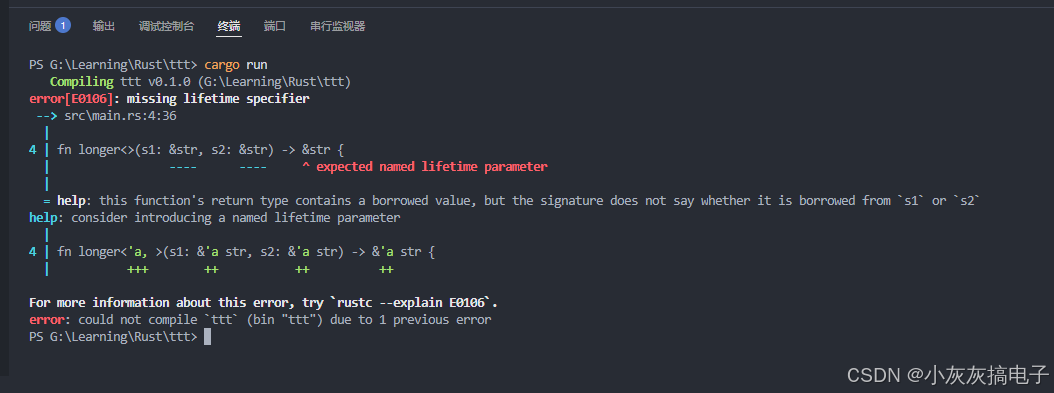Rust 生命周期详解
- 一、Rust 生命周期详解
- 1、生命周期的本质
- 2、基础语法与使用
- 3、生命周期省略规则
- 4、高级生命周期模式
- 5、生命周期与特性(Traits)
- 6、常见场景与解决方案
- 7、生命周期错误诊断
- 8、生命周期与并发
- 9、最佳实践
- 二、代码示例
一、Rust 生命周期详解
1、生命周期的本质
- 核心目标:确保引用始终指向有效内存,防止悬垂引用(Dangling References)、明确引用的作用域关系。
- 实现方式:编译器通过静态分析跟踪引用的作用域,验证引用是否在数据有效期内使用。
- 关键特点:
- 生命周期是编译期概念,不影响运行时性能。
- 生命周期注解(如
'a)描述引用之间的关系,不改变实际作用域。
2、基础语法与使用
注解格式:撇号后接小写标识符(如
'a,'ctx)。函数签名示例:
fn longest< 'a> (s1: & 'a str, s2: & 'a str) -> & 'a str { if s1.len() > s2.len() { s1 } else { s2 } }'a表示输入和输出共享同一生命周期约束。- 实际调用时,
'a取s1和s2中较短的生命周期。
结构体中的生命周期:
struct Book< 'a> { title: & 'a str, // 引用字段必须标注生命周期 }结构体实例的生命周期不能超过
title引用的数据。
3、生命周期省略规则
编译器在以下场景自动推断生命周期(无需显式注解):
- 规则 1:每个引用参数分配独立生命周期。
fn first_word(s: & str) -> & str // 隐式转为: fn first_word<'a>(s: &'a str) -> &'a str - 规则 2:若只有一个输入生命周期,它被赋予所有输出生命周期。
- 规则 3:方法中若含
&self或&mut self,输出生命周期与self绑定。impl< 'a> Book< 'a> { fn title(& self) -> & str { self.title } // 自动应用规则3 }
4、高级生命周期模式
生命周期子类型(Subtyping):
struct Context< 's> (& 's str); struct Parser< 'c, 's: 'c> { context: & 'c Context< 's> , // 's 必须比 'c 存活更久 }'s: 'c表示's至少和'c一样长。泛型中的生命周期约束:
struct Ref< 'a, T: 'a> (& 'a T); // T 必须比 'a 存活更久或为静态类型静态生命周期
'static:let s: & 'static str = "常量字符串"; // 数据存活整个程序周期需谨慎使用:真实
'static数据极少(如字符串字面量)。
5、生命周期与特性(Traits)
特性对象生命周期:
trait Display { /* ... */ } let obj: Box< dyn Display> ; // 默认隐含 'static let obj: Box< dyn Display + 'static> ; // 显式标注高阶生命周期(HRTBs):
fn apply< F> (f: F) where F: for< 'a> Fn(& 'a i32) // 接受任意生命周期的引用 { let x = 42; f(&x); }
6、常见场景与解决方案
返回引用:必须绑定到输入参数。
// 错误:返回局部变量引用 fn invalid() -> & str { "hello" } // 正确:返回输入引用 fn valid< 'a> (s: & 'a str) -> & 'a str { s }结构体方法:自动应用省略规则。
impl< 'a> Book< 'a> { fn compare(& self, other: & Book) -> & str { // 编译器自动推断 &self 和 other 的生命周期关系 } }闭包与生命周期:通常自动推断,但复杂场景需注解:
let closure = |x: & i32, y: & i32| -> & i32 { ... }; // 可能需显式标注
7、生命周期错误诊断
- 典型错误:
let r; { let x = 5; r = &x; // 错误:`x` 的生命周期短于 `r` } println!("{}", r); - 解决方案:
- 缩短引用持有时间。
- 延长被引用数据的生命周期(如使用
Rc/Arc)。 - 重构代码避免跨作用域引用。
8、生命周期与并发
- 跨线程传递引用:需满足
'static或使用作用域线程。use std::thread; let data = vec![1, 2, 3]; thread::scope(|s| { s.spawn(|| println!("{:?}", data)); // 安全:线程在 data 有效期内结束 });
9、最佳实践
- 优先依赖编译器推断,仅在必要时显式标注。
- 结构体含引用时必须标注生命周期。
- 避免过度使用
'static,优先考虑所有权转移(如String代替&str)。 - 复杂关系使用生命周期子类型(
'a: 'b)明确约束。
二、代码示例
写一个比较字符串长度的函数:
fn longer(s1: &
str, s2: &
str) ->
&
str {
if s2.len() > s1.len() {
s2
} else {
s1
}
}
fn main() {
let s1 = "Hello";
let s2 = "World!";
let longest: &
str = longer(s1, s2);
println!("The longest string is: {}", longest);
}这段代码是编译不通过的,编译信息如下:
PS G:\Learning\Rust\ttt> cargo run
Compiling ttt v0.1.0 (G:\Learning\Rust\ttt)
error[E0106]: missing lifetime specifier
--> src\main.rs:4:34
|
4 | fn longer(s1: &
str, s2: &
str) ->
&
str {
| ---- ---- ^ expected named lifetime parameter
|
= help: this function's return type contains a borrowed value, but the signature does not say whether it is borrowed from `s1` or `s2`
help: consider introducing a named lifetime parameter
|
4 | fn longer<
'a>
(s1: &
'a str, s2: &
'a str) ->
&
'a str {
| ++++ ++ ++ ++
For more information about this error, try `rustc --explain E0106`.
error: could not compile `ttt` (bin "ttt") due to 1 previous error
PS G:\Learning\Rust\ttt>原因是返回值引用可能会返回过期的引用。此时就需要进行显示的生命周期标注,修改程序如下:
fn longer<
'a>
(s1: &
'a str, s2: &
'a str) ->
&
'a str {
if s2.len() > s1.len() {
s2
} else {
s1
}
}
fn main() {
let s1 = "Hello";
let s2 = "World!";
let longest: &
str = longer(s1, s2);
println!("The longest string is: {}", longest);
}编译运行:
PS G:\Learning\Rust\ttt> cargo run
Compiling ttt v0.1.0 (G:\Learning\Rust\ttt)
Finished `dev` profile [unoptimized + debuginfo] target(s) in 0.40s
Running `target\debug\ttt.exe`
The longest string is: World!
PS G:\Learning\Rust\ttt>加入‘a并不能够改变引用的生命周期,但可以在合适的地方声明两个引用的生命周期一致。返回的引用生命周期要和s1.s2的生命周期一致。

